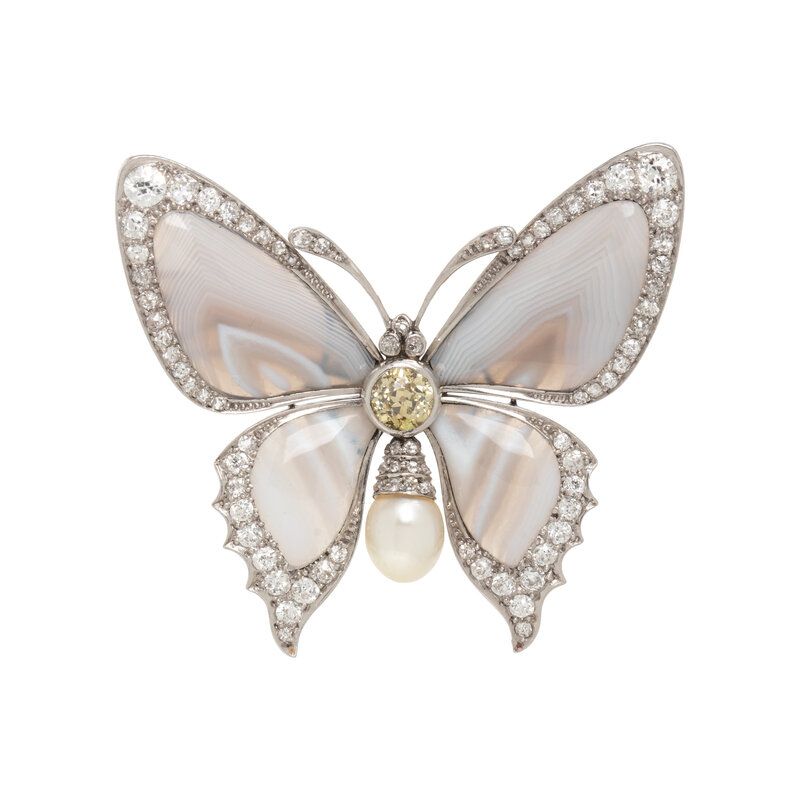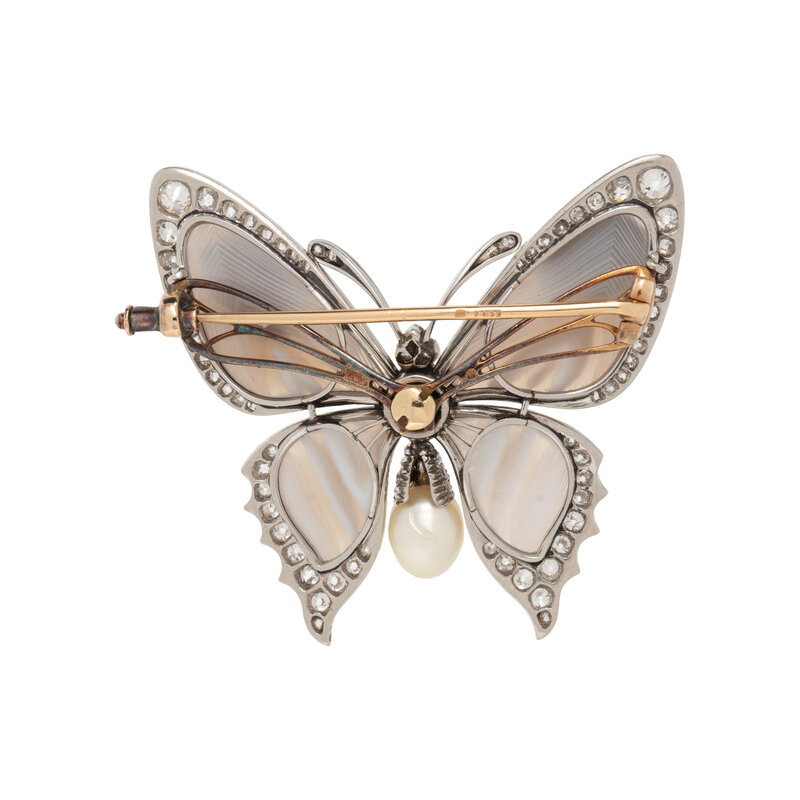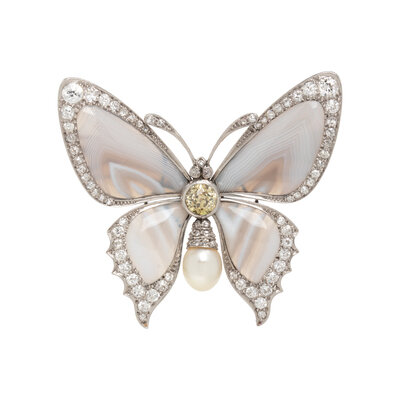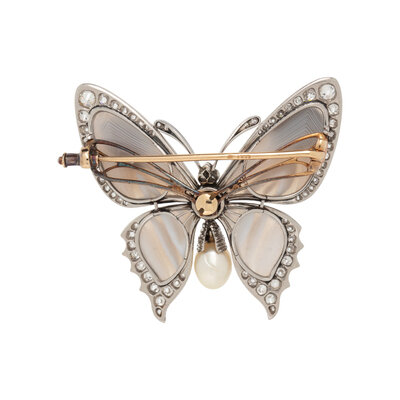BANDED AGATE, DIAMOND, AND CULTURED PEARL BUTTERFLY BROOCH
Sale 2047 - Important Jewelry
Sep 12, 2024
10:00AM CT
Live / Chicago
Own a similar item?
Estimate
$1,800 -
2,200
Price Realized
$3,493
Sold prices are inclusive of Buyer’s Premium
Lot Description
BANDED AGATE, DIAMOND, AND CULTURED PEARL BUTTERFLY BROOCH
Containing banded agate wings, one old European cut yellow diamond (origin of color not tested) weighing approximately 0.35 carat, one cultured pearl measuring approximately 6.95 x 6.00 mm, and old European, single and rose cut diamonds weighing approximately 0.85 carat total. Mounted in platinum and yellow gold. 1 1/8 x 1 1/2 inches.
Stamp: R&F.
Gross weight: 7.80 dwt.
Stamp: R&F.
Gross weight: 7.80 dwt.
Property from the Collection of Carl and Rosa Askonas
Treasures Saved from Darkness
Carl Askonas (1883 – 1946) and Rosa Fürth (1891 – 1980) were the toast of Viennese Society in the 1920s and 1930s. Carl was a successful businessman whose factories in Austria, Hungary, Czechoslovakia, and Germany produced gloves and hosiery sold throughout the region, and Rosa was a socialite and avid patron of the arts. The couple were art lovers through and through, frequently seen at the concerts, operas, and ballets that Vienna was famous for at the time. They were also passionate collectors who amassed a remarkable collection of art, artifacts, and jewelry from across the continent.
The couple were married in 1919, a tumultuous time in Europe that saw borders redrawn multiple times in the aftermath of World War I. The collapse of the Austro-Hungarian Empire gave Carl and Rosa the rare opportunity to claim new citizenship and the couple were able to declare themselves Czechoslovakian. This would prove to be a fateful decision 16 years later when that citizenship allowed them to flee the rise of Nazism in Austria. Other members of Carl’s family were not so fortunate.
To depart Austria in 1938-39, the Nazis required the Askonas family to list their art collection and real estate holdings in export documents. Some of their art objects were allowed to leave with them, but several pieces and all their real estate were confiscated. Later, a portion of the Askonas art collection was lost forever in the sinking of the cargo ship Ronda in September 1939. What remained has been treasured by four generations of the family.
Rosa’s jewelry was hand-carried out of Austria during this frightening escape from Vienna. Family lore tells that she sewed the jewelry into the hem of her skirt and pinned other items to her underwear to evade detection by the Nazis. For decades, most of the jewelry was hidden in safe deposit boxes as an “emergency fund” in case of economic difficulty.
Offered here are many of the Renaissance and antique jewelry pieces that Rosa bravely hid from the Nazis as she fled for Czechoslovakia. The pieces are offered by the grandchildren of Carl and Rosa in the hopes that they can once again be seen and enjoyed. If they make their way to a concert, ballet, or opera, all the better.
Carl Askonas (1883 – 1946) and Rosa Fürth (1891 – 1980) were the toast of Viennese Society in the 1920s and 1930s. Carl was a successful businessman whose factories in Austria, Hungary, Czechoslovakia, and Germany produced gloves and hosiery sold throughout the region, and Rosa was a socialite and avid patron of the arts. The couple were art lovers through and through, frequently seen at the concerts, operas, and ballets that Vienna was famous for at the time. They were also passionate collectors who amassed a remarkable collection of art, artifacts, and jewelry from across the continent.
The couple were married in 1919, a tumultuous time in Europe that saw borders redrawn multiple times in the aftermath of World War I. The collapse of the Austro-Hungarian Empire gave Carl and Rosa the rare opportunity to claim new citizenship and the couple were able to declare themselves Czechoslovakian. This would prove to be a fateful decision 16 years later when that citizenship allowed them to flee the rise of Nazism in Austria. Other members of Carl’s family were not so fortunate.
To depart Austria in 1938-39, the Nazis required the Askonas family to list their art collection and real estate holdings in export documents. Some of their art objects were allowed to leave with them, but several pieces and all their real estate were confiscated. Later, a portion of the Askonas art collection was lost forever in the sinking of the cargo ship Ronda in September 1939. What remained has been treasured by four generations of the family.
Rosa’s jewelry was hand-carried out of Austria during this frightening escape from Vienna. Family lore tells that she sewed the jewelry into the hem of her skirt and pinned other items to her underwear to evade detection by the Nazis. For decades, most of the jewelry was hidden in safe deposit boxes as an “emergency fund” in case of economic difficulty.
Offered here are many of the Renaissance and antique jewelry pieces that Rosa bravely hid from the Nazis as she fled for Czechoslovakia. The pieces are offered by the grandchildren of Carl and Rosa in the hopes that they can once again be seen and enjoyed. If they make their way to a concert, ballet, or opera, all the better.
Condition Report
Auction Specialists



